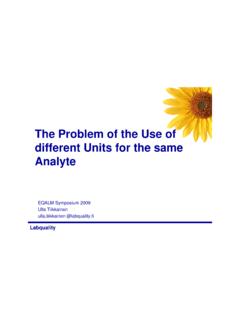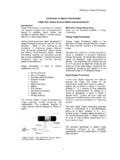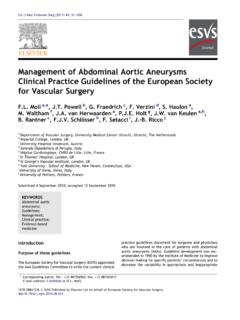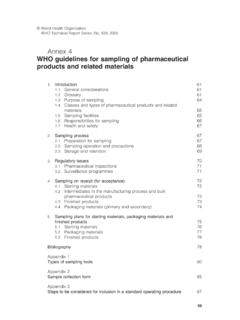Transcription of Use of a ISO 13528 template for quantitative …
1 Use of a ISO 13528 template for quantitative schemes : the issuesAnnette ThomasISO 17043 and homogeneity and Stability ISO 17043 requires that an EQA provider demonstrates sufficient homogeneity and stability of the material using valid statistical methods. The Standard refers the reader to ISO 13528 -Statistical methods for use in proficiency testing by interlaboratory comparisons and the IUPAC International Harmonized Protocol. The procedure described in ISO 13528 Annex B is most suited for large quantitative schemes with little guidance provided for Schemes where there are insufficient number of samples for statistical validity, or where split sample analysis is inappropriate. There is little or no guidance as to the design of suitable homogeneity and stability testing protocols for qualitative analytes.
2 Issue 1 wide method CVThe standard statistical approach for homogeneity and stability includes calculation of the general average, the within sample and between sample standard deviation. The samples are considered to be adequately homogeneous if the between sample sd is * Standard deviation for proficiency assessment (SDPT) t represents the sample (t = 1 , 2 .., g) k represents the test portion (k = 1, 2)Calculate sample averages as:and the between-test-portion ranges as:Calculate the general average: the standard deviation of sample averages:and the within-samples standard deviation:Calculate the between-samples standard deviation as:Homogeneous if Issue 1 wide method CVbetween-samples standard deviation =If SDPT= then SD allow = SDPT= If Sx= and Sw= Ss= ( )= ( )= Sw> Sxlook at analytical variation of method If Ssis negative can t use standard equation use alternative SDallowwhich takes into account within sample SD allow.
3 Calculate F1 and F2 are from standard statistical tables, If ss > c then there is evidence that the batch of material is not sufficiently homogeneousIssue 1 wide method CVFor 10 samples, F1 = and F2 = = x SD2allow+ (within sample SD)2c = x + x = + = c = : GlucoseAnalyte: GlucoseAnalyte: GlucoseBatch no: (please enter)Result aResult bSample AveResult aResult bSample AveResult aResult bSample AveSample Sample SD (SD diff) of sample Between sample SD#NUM! WEQAS SD for this level (calculated from precision profile & general average or POCT criteria (in%)) *WEQAS al SAMPLES SENT TO ANALYSER:Between sample SD (1) must be < *WEQAS SD (2) or c (3)DATE OF ANALYSIS SD 2 al l ow = ( *WEQAS SD)2 c = *SD2 allow + *(within sample SD)2 SampleSampleSampleIf Within sample SD > Sample Av SD Compare d2and remove data points (use Cochran s test if 2-Where the SDPTis smallImpossible to achieve x SD Tight performance criteria based on Clinical allowable limits.)
4 Challenging samples near the analytical limits of the assay. In these cases the criterion should be expanded to allow for the sampling errors. Issue 3 Random v Systematic ISO Guide 34 -systematic sampling in a continuous process may be a better way to detect inhomogeneity rather than random sampling. Evaluation of the data should include investigation of a trend (or drift) in analysis of the homogeneity measurements, or a trend during the dispensing or production processes. Analyte: GlucoseAnalyte: GlucoseBatch no: (please enter)Result aResult bSample AveResult aResult bSample AveSample Sample SD (SD diff) of sample Between sample SD for this level *WEQAS SAMPLES SENT TO ANALYSER:Between sample SD (1) must be < *WEQAS SD (2) or DATE OF ANALYSIS SD 2 al l ow = ( *WEQAS SD)2 SampleSampleRandom sampling approachSystematic sampling approachAnalysis sequence of all samples should be random for both approaches to minimise affects of analyser driftTrend Analysis - Random pairBias to General AvPair 1 Pair 2 Trend Analysis - Systematic pairBias to General AvPair 1 Pair 2 Systematic sampling provides greater information than random samplingIssue 4 Small sample nos.
5 Use fewer points in ISO 13528 template and use range instead of SD If n = 2,3 then (xhigh xlow) = ss If n =4,5,6 then (xhigh xlow) = ss If n =7,8,9 then (xhigh-xlow)/2 = ss Alternative approach is to assess the observed SDPT against the predicted Standard deviation calculated from the Precision profile derived from previous 5 instead of 10 pairs Analyte: GlucoseAnalyte: GlucoseBatch no: (please enter)Result aResult bSample AveResult aResult bSample AveSample 6 Sample 7 Sample 8 Sample 9 Sample 10 General Sample SD (SD diff) of sample Between sample WEQAS SD for this level (calculated from precision profile & general average or POCT criteria (in%)) *WEQAS SAMPLES SENT TO ANALYSER:Between sample SD (1) must be < *WEQAS SD (2) or DATE OF ANALYSIS SD 2 all ow = ( *WEQAS SD)2 SampleSampleCompare against previous SDPrecision Profile Glucose y = + + = = + + = Concentration (mmol/L)SDJan '99 - Mar '00 Sep '04 - Jan '05 Feb '05 - Jul '05 Jul '05-Nov'05 Dec '05 - Apr '06 May '06 - Sep '06 Oct '06 - Feb '07 Marc '07 - Jul '07 Aug '07 - Mar '08 Biological goals691-702711-722731-742751-762771-782 791-802 Poly.
6 (731-742)Linear (Biological goals)Assessment criterion for qualitative Schemes Not covered in ISO 13528 Split sampling procedure could be followed as for quantitative analytes. The samples could be considered homogeneous if all samples (100% responses) tested gave the same result. If this is not the case compare the variability of results from the within vial results and the between vial results. calculate false negatives/ true positive % for within vial calculate false negatives / true positive % for between vials false negatives/ true positive % for between vials false positive / true positive % for within homogeneity and stability testing requires a more pragmatic approach than the procedure described in ISO 13528 :2005









